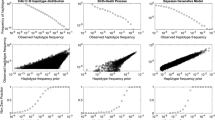Abstract
The prevalence of nonpaternity in human societies is difficult to establish. To obtain a current and fairly unbiased estimate of the nonpaternity rate in Germany, we analysed a dataset consisting of 971 children and their parents in whom human leukocyte antigen (HLA) typing had been carried out in the context of bone marrow transplantation. In this sample, nine exclusions (0.93%) could be identified on the basis of more than 300 HLA-haplotypes defined by four HLA genes. Given this number of exclusions, a maximum likelihood estimate of the nonpaternity rate in the population of 0.94% was obtained with asymptotic 95% confidence limits of 0.33% and 1.55%, respectively. This result is in accordance with recent surveys as well as findings from Switzerland for a comparable sample, and it suggests that earlier estimates of the nonpaternity rate which were often in excess of 10% may have been largely exaggerated.
Similar content being viewed by others
References
Aguilar-Martinez, P., Jourdan, E., Brun, S., Cunat, S., Giansily-Blaizot, M., Pissard, S., & Schved, J. F. (2007). A novel mutation of the beta-globin gene promoter (−102 C > A) and pitfalls in family screening. American Journal of Hematology, 82, 1088–1090.
Anderson, K. G. (2006). How well does paternity confidence match actual paternity? Evidence from worldwide nonpaternity rates. Current Anthropology, 47, 513–520.
Bellis, M. A., & Baker, R. R. (1990). Do females promote sperm competition: Data for humans. Animal Behaviour, 40, 997–999.
Bellis, M. A., Hughes, K., Hughes, S., & Ashton, J. R. (2005). Measuring paternal discrepancy and its public health consequences. Journal of Epidemiology and Community Health, 59, 749–754.
Bodmer, W. F., & Bodmer, J. G. (1978). Evolution and function of the HLA system. British Medical Bulletin, 34, 309–316.
Bonaiti-Pellié, C., Poisson, N., Bechtel, Y., & Bechtel, P. (1992). Sensitivity of transmission probabilities to paternity exclusion in segregation analysis. Genetic Epidemiology, 9, 67–71.
Brock, D. J. H., & Shrimpton, A. E. (1991). Non-paternity and prenatal genetic screening. Lancet, 338, 1151.
Broman, K. W. (1999). Cleaning genotype data. Genetic Epidemiology, 17, 79–83.
Buss, D. M., Larsen, R. J., Westen, D., & Semmelroth, J. (1992). Sex differences in jealousy: Evolution, physiology, and psychology. Psychological Science, 3, 251–255.
Buss, D. M., & Shackelford, T. K. (1997). From vigilance to violence: Mate retention tactics in married couples. Journal of Personality and Social Psychology, 72, 346–361.
Cerda-Flores, R. M., Barton, S. A., Marty-Gonzalez, L. F., Rivas, F., & Chakraborty, R. (1999). Estimation of nonpaternity in the Mexican population of Nuevo Leon: Validation study with blood group markers. American Journal of Physical Anthropology, 109, 281–293.
Chakravarti, A., & Li, C. C. (1983). The probability of exclusion based on the HLA locus. American Journal of Human Genetics, 35, 1048–1052.
Cohen, J. (1977). Reproduction. London: Butterworths.
Dockerty, J. D., Draper, G., Vincent, T., Rowan, S. D., & Bunch, K. J. (2001). Case-control study of parental age, parity and socioeconomic level in relation to childhood cancers. International Journal of Epidemiology, 30, 1428–1437.
Doll, R. (1989). The epidemiology of childhood leukaemia. Journal of the Royal Statistical Society A, 152, 341–351.
Edwards, J. H. (1957). A critical examination of the reputed primary influence of ABO phenotype on fertility and sex ratio. British Journal of Preventive & Social Medicine, 11, 79–89.
Euler, H. A., & Weitzel, B. (1996). Discriminative grandparental solicitude as reproductive strategy. Human Nature, 7, 39–59.
Gaulin, J. C., McBurney, D. H., & Brakeman-Wartell, S. L. (1997). Matrilateral biases in the investment of aunts and uncles: A consequence and measure of paternity uncertainty. Human Nature, 8, 139–151.
Hemminki, K., & Mutanen, P. (2001). Birth order, family size, and the risk of cancer in young and middle-aged adults. British Journal of Cancer, 84, 1466–1471.
Henke, L., Fimmers, R., Josephi, E., Cleef, S., Dülmer, M., & Henke, J. (1999). Usefulness of conventional blood groups, DNA-mini-satellites, and short tandem repeat polymorphisms in paternity testing: A comparison. Forensic Science International, 103, 133–142.
Hoier, S., Euler, H. A., & Hänze, M. (2001). Diskriminative Fürsorglichkeit von Tanten und Onkeln: Eine empirische Untersuchung aus evolutionspsychologischer Perspektive [Discriminative solicitude of aunts and uncles: An empirical investigation from an evolutionary psychology perspective]. Zeitschrift für Differentielle und Diagnostische Psychologie, 3, 206–215.
IARC (International Agency for Research on Cancer). (1997). Social inequalities and cancer. IARC Scientific Publications 138. Lyon.
Jobling, M. A., Hurles, M. E., & Tyler-Smith, C. (2004). Human evolutionary genetics. New York: Garland.
Johnstone, J. M. (1954). Heterospecific pregnancy. British Journal of Preventive & Social Medicine, 8, 117–123.
Krawczak, M., Böhm, I., Nürnberg, P., Hampe, J., Hundrieser, J., Pöche, H., Peters, C., Slomski, R., Kwiatkowska, J., Nagy, M., Pöpper, A., Epplein, J. T., & Schmidtke, J. (1993). Paternity testing with oligonucleotide multilocus probe (CAC)5/(GTG)5: A multicenter study. Forensic Science International, 59, 101–117.
Lathrop, G. M., Hooper, A. B., Huntsman, J. W., & Ward, R. H. (1983). Evaluating pedigree data. I. The estimation of pedigree error in the presence of marker mistyping. American Journal of Human Genetics, 35, 241–262.
Laumann, E. O., Gagnon, J. H., Michael, R. T., & Michaels, S. (1994). The social organization of sexuality: Sexual practices in the United States. Chicago: University of Chicago Press.
MacIntyre, S., & Sooman, A. (1991). Non-paternity and prenatal genetic screening. Lancet, 338, 869–871.
Philipp, E. E. (1973). Comment in discussion: Moral, social, and ethical issues. In G. E. W. Wolstenholme & D. W. Fitzsimons (Eds.), Law and ethics of A.I.D. and embryo transfer (pp. 663–666). Amsterdam: Associated Scientific Publishers.
Platek, S. M., & Shackelford, T. K. (2006). Female infidelity and paternal uncertainty. New York: Cambridge University Press.
Procopio, M. (2005). Misattributed paternity: A bias in the family studies in schizophrenia? Medical Hypotheses, 64, 1046–1049.
Ritz, E. (1985). The clinical spectrum of hereditary nephritis. Nephrology forum, Kidney International, 27, 83–92.
Sasse, G., Müller, H., Chakraborty, R., & Ott, J. (1994). Estimating the frequency of nonpaternity in Switzerland. Human Heredity, 44, 337–343.
Schacht, L. E., & Gershowitz, H. (1963). Frequency of extramarital children as determined by blood groups. In F. Brockington, J. Francois, & L. Gedda (Eds.), Proceedings of the Second International Congress on Human Genetics (pp. 894–897). Rome: Instituto G. Mendel.
Stewart, A. D. (1989). Screening for cystic fibrosis. Nature, 341, 696.
Sykes, B., & Irven, C. (2000). Surnames and the Y chromosome. American Journal of Human Genetics, 66, 1417–1419.
Voracek, M., Haubner, T., & Fisher, M. L. (2008). Recent decline in nonpaternity rates: A cross-temporal meta-analyses. Psychological Reports, 103, 799–811.
Wiederman, M. W. (1997). Extramarital sex: Prevalence and correlates in a national survey. Journal of Sex Research, 34, 167–174.
WMA (World Medical Association) (2008). World Medical Association Declaration of Helsinki: ethical principles for research involving human subjects. Adopted by the 18th WMA, Helsinki, Finland, June, 1964. Amended by the 59th WMA General Assembly, Seoul, Korea, October, 2008. Retrieved February 12, 2011, from http://www.wma.net/en/30publications/10policies/b3/17c.pdf
ZEKO (Zentrale Ethikkommission bei der Bundesärztekammer). (1999). Zur Verwendung von patientenbezogenen Informationen für die Forschung in der Medizin und im Gesundheitswesen [On the use of patient-based information in medical research and the health care system]. Deutsches Ärzteblatt, 96, A-3201–A-3204.
Author information
Authors and Affiliations
Corresponding author
Rights and permissions
About this article
Cite this article
Wolf, M., Musch, J., Enczmann, J. et al. Estimating the Prevalence of Nonpaternity in Germany. Hum Nat 23, 208–217 (2012). https://doi.org/10.1007/s12110-012-9143-y
Published:
Issue Date:
DOI: https://doi.org/10.1007/s12110-012-9143-y




